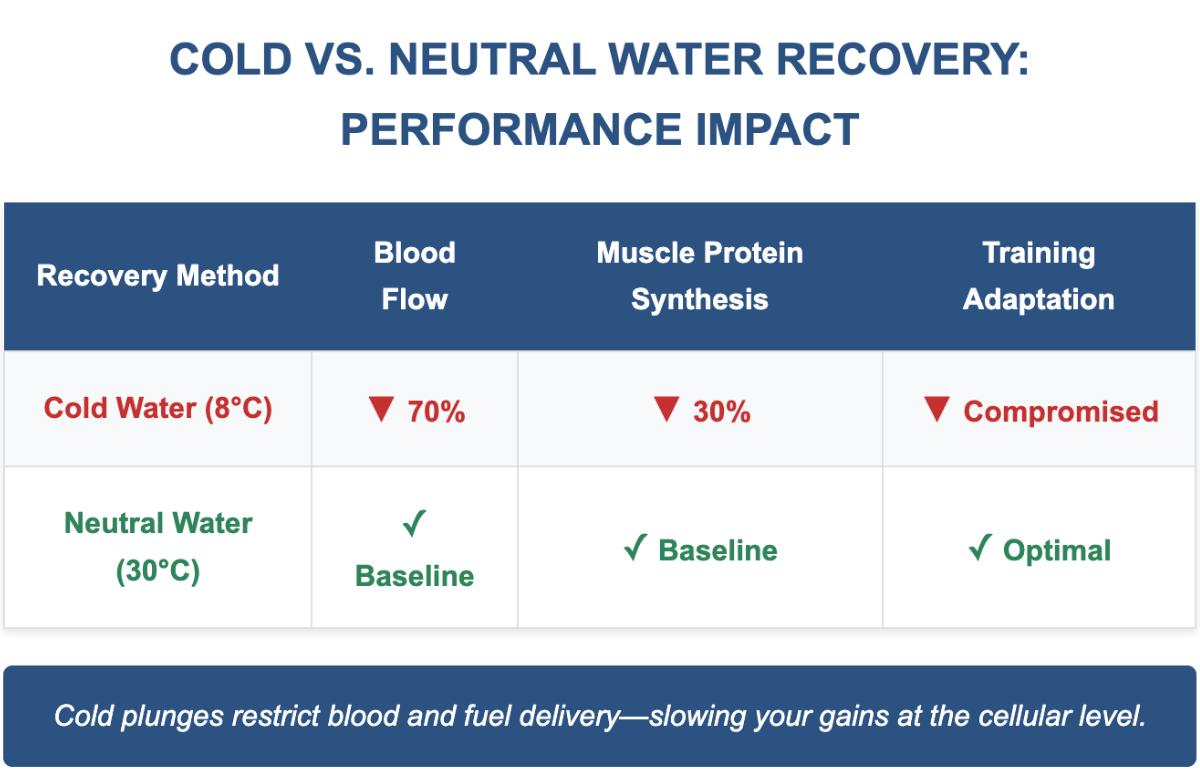The Cold Truth: Why Cold Plunges Could Be Killing Your Gains
Estimated read time: 3.26 minutes (just long enough for me to go from ‘I feel great’ to ‘I might actually puke’ during mile 1 of my marathon). 🤮
Hey Performance Nerds! Jonah here. 🤓
Have you ever sprinted into a freezing tub after a hard run or lift thinking you were boosting recovery? I have cold, hard news.
New science shows cold plunges may be blunting your gains—not speeding them up.
Today we’re breaking down:
🧬 The surprising science behind cold plunges and muscle recovery
⛔️ When cold water could actually stall your progress
⚖️ Smart ways to recover that don't sabotage your adaptations
🙏 Thank You, London
Hey team— I'm still buzzing from London's streets! Your messages, cheers, and high-fives carried me through every challenging mile in ways no carb gel ever could. Thank you from the bottom of my heart.
The clock told a different story than I trained for, but knowing this newsletter helped power your PRs is the medal I'm taking home.
Your support fueled my purpose, and I can't wait to keep giving it back as we chase our next start lines together. 🏁
SiS is now the official sponsor of Marathon Science. Their performance products—like fueling bars, hydration mixes, and recovery supplements—are trusted by pros and grounded in real sport science.


🧠 The Science: Cold Water Can Limit Muscle Recovery
Think cold plunges are recovery gold? Not so fast.
In a recent study, 12 active men did a heavy lifting session, then dunked one leg in cold water (8°C) and the other in thermoneutral water (30°C).
Here’s what happened:
🩸 Blood flow in the cold leg dropped by 70%
🧩 Muscle protein synthesis dropped by 30%

"Your muscle recovery is like pizza delivery. Cold plunging shuts down the roads. No pizza = no gains." – Sciencey Jonah (2025)
Translation: Cold plunges shut down nutrient delivery and muscle rebuilding—at the cellular level.
🤔 "But I Feel Better After Cold Plunges..."
Cold might reduce soreness—temporarily.
But here’s the catch: soreness relief ≠ real adaptation.
It’s like popping ibuprofen for a sprained ankle. You might feel better… but your body hasn’t healed.
Cold plunging may make you feel fresh while slowing the adaptations you're training for.
And this isn’t just about strength gains:
Cold plunges can stall the endurance adaptations you're working so hard for:
They restrict amino acid delivery—crucial for building more mitochondria
They shut down PGC-1α, the molecule that signals your cells to grow your aerobic engine
Yes, I judge you if you cold plunge after workouts. – Augie (My Dog), Chief Recovery Officer 🐶❄️💢
Translation: You’re training for a Ferrari engine—but cold plunges might be throwing it into neutral.
🛠️ How to Recover Smarter (and Still Use Cold if You Want To)
Here’s how to recover without losing gains. Let’s make this practical.
❌ When to Avoid Cold Plunges:
After strength training, long runs, or speed sessions
When you're chasing muscle or aerobic gains
✅ When Cold Is OK:
After races or competitions with short recovery windows—to reduce feelings of soreness
If you enjoy cold exposure, try it before workouts or wait a few hours after training
🧠 What to Do Instead:
Prioritize nutrition: Fuel your post-session with carbs + protein (recovery shake + real meal), and meet your daily macro targets to support full recovery.
Keep moving: Gentle cycling or walking maintains blood flow and speeds up healing.
Train smart: Follow a progressive, well-structured plan to maximize adaptations.
Choose heat over ice: Try thermoneutral baths (~30°C), warm showers, or sauna sessions to boost circulation—without blunting gains.
TL;DR: Cold plunges look cool on Instagram. But carbs, protein, and sleep? Way better for your quads. 💪

✅ Practical Summary: Should You Cold Plunge After Running?
🩸 Blood Flow Down: Cold plunges reduce blood supply by up to 70%
🧩 Muscle Repair Down: Protein synthesis drops 30%
❌ Skip the Ice: Avoid after strength or endurance sessions
✅ Do This Instead: Eat well, follow a periodized training plan, and sleep for better recovery

Are You a True Running Nerd? Prove it.. 🧐
Welcome to the prove you’re a nerd section. Each week, I ask a question about a common running science myth.
Answer correctly, and you’ll be entered into a weekly raffle to win a package of Jonah’s favorite supplements.
What primarily determines whether your body burns more fat or carbohydrates during a run, assuming everything else (like diet, duration, and fitness level) stays the same?

Last Week’s Results: Cramp Myth Busters! ⚡️🦵🧂
Boom! Most of you kicked that old banana myth to the curb and locked in on the real reason marathon cramps strike. 💥
The correct answer? Muscular fatigue and altered neuromuscular control. It’s less about your sodium stash and more about pushing tired muscles past their breaking point—especially when your pacing or strength work hasn’t kept up with your mileage. 🧠💡
Here’s how the votes stacked up:
🟨 A. Losing too much salt from sweat 🧂 – 121 votes
⬜️ B. Dehydration from not drinking enough water 💧 – 38 votes
🟩 C. Muscular fatigue and altered neuromuscular control ⚡️ – 281 votes ✅
⬜️ D. Not eating enough bananas 🍌 – 4 votes
Moral of the story? Cramping is a training issue, not a potassium panic. Want fewer cramps? Build stronger, more fatigue-resistant legs—and save the bananas for your smoothie. 🏃♂️💪🍌

Nerdy Finds of the Week 📚🧑🔬
This section includes my favorite research, podcasts or books about running/lifting science.
Unpacking Creatine Monohydrate with Dr Darren Candow & Dr Dan Plews - PILLAR Podcast
🔬 Core Finding
• Creatine isn’t just for strength—it helps endurance athletes recover faster, stay cooler, and handle more training.
📊 Key Research Points
• Daily 5 g cuts soreness by lowering inflammation and oxidative stress.
• Boosts cell water: muscles + plasma hold up to 92% more fluid.
• Body comp improves: +1–2 kg lean mass, −0.5–1 kg fat.
• Cramping risk drops with steady dosing (not loading).
• Enhances repeat sprint, hill, and cross-training efforts.
🛠️ Practical Applications
• 🍽️ Take 5 g creatine/day ➜ Reduce muscle damage and bounce back quicker.
• ⚡ No 20 g loading ➜ Avoid bloat and gain the same benefits in ~3 weeks.
• 🌡️ Training in heat? ➜ Creatine pulls water into cells for cooling + heart support.
• 🏁 Race week? Pause 7–10 days before weight-sensitive events—stores stay topped for ~4 weeks.
🎯 Bottom Line
• Creatine helps you recover faster, train harder, and stay hydrated—especially in the heat.
• Dose low, stay consistent, and skip the loading phase for endurance-friendly benefits.

Don’t forget: You + Science = AWESOMENESS 😎
Yours in science,
Jonah
P.S. - We have a crew of 15,270+ nerds here who are running FAST using science.
Did you need running science advice or tips? 🏃♀️💨🧪
Reply with your question, Augie and I (pictured below) will get back to you with science-backed tips!


Enjoy the newsletter? Please forward to a pal. It only takes 18 seconds. Making this one took 11.23 hours.
Please email me directly if you’re interested in references for this week!

